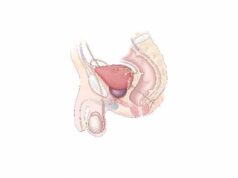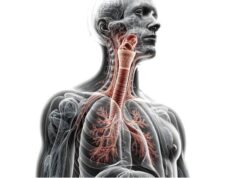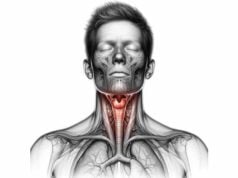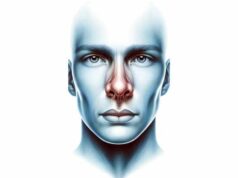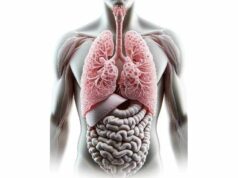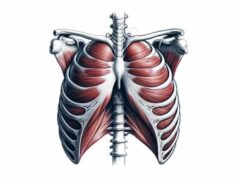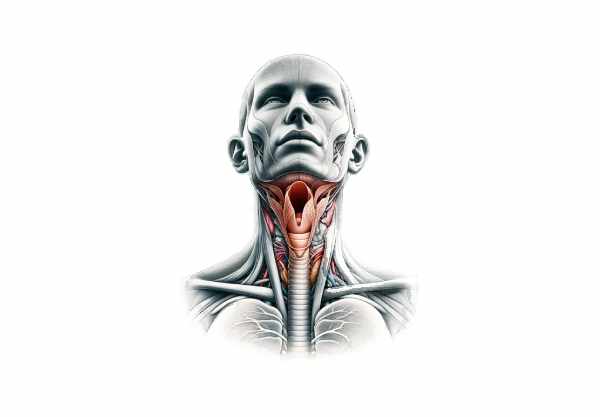
The larynx, commonly known as the voice box, is a critical organ located in the neck that plays a central role in breathing, voice production, and airway protection. Despite its relatively small size, the larynx is a complex structure composed of cartilage, muscles, and nerves, all of which work together to regulate airflow and produce sound. It is essential for clear communication and safeguarding the lower respiratory tract during swallowing. This guide provides an in-depth look at the larynx’s intricate anatomy, diverse physiological functions, common disorders that affect it, modern diagnostic techniques, treatment strategies, and lifestyle tips to maintain optimal laryngeal health.
Table of Contents
- Anatomy & Structure
- Physiological Functions
- Common Disorders
- Diagnostic Techniques
- Treatment Options
- Nutritional Support & Supplements
- Lifestyle Practices
- Trusted Resources
- Frequently Asked Questions
Anatomy & Structure
The larynx is a multifaceted organ located in the anterior neck, extending from approximately the level of the third to the sixth cervical vertebrae. It is composed of multiple cartilaginous structures, intrinsic and extrinsic muscles, and connective tissues that work together to provide both rigidity and flexibility. This unique combination allows the larynx not only to protect the airway but also to produce sound.
Cartilaginous Framework
- Thyroid Cartilage:
The largest and most prominent cartilage, the thyroid cartilage forms the bulk of the anterior laryngeal wall. Its shield-like shape, often visible as the Adam’s apple, provides structural support and protection for the underlying vocal apparatus. - Cricoid Cartilage:
Located inferior to the thyroid cartilage, the cricoid cartilage is the only complete ring in the larynx. It plays a crucial role in maintaining airway patency and serves as an anchoring point for various intrinsic muscles. - Epiglottis:
This leaf-shaped cartilage functions as a protective flap that covers the laryngeal inlet during swallowing, preventing food and liquids from entering the trachea. - Arytenoid Cartilages:
Pyramid-shaped cartilages that sit atop the cricoid cartilage, the arytenoids control the tension and position of the vocal cords, directly influencing voice production. - Corniculate and Cuneiform Cartilages:
These small, auxiliary cartilages support the aryepiglottic folds and provide additional rigidity to the laryngeal framework.
Vocal Apparatus
- Vocal Cords (Folds):
The true vocal cords are paired bands of muscle and elastic tissue covered by a mucous membrane. They vibrate as air passes through them, generating sound. Their tension, length, and mass determine the pitch and quality of the voice. - Vestibular Folds (False Vocal Cords):
Located just above the true vocal cords, these structures do not participate in sound production but help protect the airway by preventing foreign particles from entering during swallowing. - Glottis:
The space between the true vocal cords, the glottis is crucial for modulating sound and regulating airflow during breathing and phonation.
Intrinsic Musculature
Intrinsic muscles are responsible for fine control of the vocal cords and overall laryngeal function. They include:
- Cricothyroid Muscle:
This muscle tenses the vocal cords, increasing pitch during phonation. - Thyroarytenoid Muscle:
It relaxes and shortens the vocal cords, lowering the pitch and contributing to vocal quality. - Lateral and Posterior Cricoarytenoid Muscles:
These muscles control the opening (abduction) and closing (adduction) of the vocal cords, regulating airflow and ensuring effective phonation. - Transverse and Oblique Arytenoid Muscles:
They assist in the adduction of the vocal cords, critical for producing clear, strong sounds.
Extrinsic Musculature
Extrinsic muscles anchor the larynx to surrounding structures and facilitate its movement during swallowing and speech. They include:
- Suprahyoid Muscles:
These muscles elevate the larynx during swallowing, helping to close the airway and protect the respiratory tract. - Infrahyoid Muscles:
They depress the larynx after swallowing and help stabilize it during speech.
Neural and Vascular Supply
- Nerve Supply:
The larynx is primarily innervated by branches of the vagus nerve. The recurrent laryngeal nerve controls most intrinsic muscles, while the superior laryngeal nerve primarily innervates the cricothyroid muscle and provides sensory input to the supraglottic region. - Blood Supply:
Arterial supply is provided by the superior laryngeal artery (a branch of the superior thyroid artery) and the inferior laryngeal artery (from the inferior thyroid artery). These vessels ensure that the laryngeal tissues receive the oxygen and nutrients required for their functions.
Physiological Functions
The larynx serves several essential roles in human physiology, encompassing respiration, phonation, and airway protection. Its intricate coordination of muscles and cartilage allows it to perform these critical functions seamlessly.
Respiratory Function
- Airflow Regulation:
The larynx forms the gateway between the upper and lower respiratory tracts. During quiet breathing, the vocal cords are positioned to allow smooth, unobstructed airflow into the trachea. The posterior cricoarytenoid muscles are key in keeping the glottis open. - Airway Patency:
The larynx ensures that the airway remains open, particularly during increased respiratory demand. Its structure prevents collapse under the negative pressure generated during inspiration, maintaining adequate ventilation.
Phonation and Sound Production
- Voice Generation:
Phonation occurs when air from the lungs passes through the closed vocal cords, causing them to vibrate. This vibration is the primary source of sound production, which is then modified by the vocal tract to produce speech and song. - Pitch and Volume Control:
Intrinsic laryngeal muscles adjust the tension and position of the vocal cords, controlling the pitch, loudness, and quality of the sound. The cricothyroid muscle increases vocal cord tension for higher pitch, while the thyroarytenoid muscle adjusts the cord’s length for lower pitch.
Airway Protection
- Swallowing Mechanism:
During swallowing, the larynx elevates and the epiglottis folds over the glottis, preventing food and liquids from entering the trachea. This protective reflex is vital in averting aspiration and subsequent respiratory complications. - Cough Reflex:
When irritants enter the airway, sensory receptors in the larynx trigger a cough reflex. This forceful expulsion of air helps clear the airway of foreign particles and mucus.
Additional Functions
- Pressure Regulation:
The larynx plays a role in the Valsalva maneuver, where a forced expiration against a closed glottis increases intra-abdominal and intrathoracic pressures. This mechanism is important in activities such as heavy lifting and defecation. - Eustachian Tube Function:
Although primarily part of the respiratory system, the larynx assists in equalizing pressure in the middle ear during swallowing and yawning, thereby supporting proper hearing function. - Contribution to Nonverbal Communication:
Beyond sound production, the movement of the larynx and associated facial expressions contribute to nonverbal communication, influencing how emotions are conveyed.
Common Laryngeal Disorders
The larynx can be affected by a range of conditions that impair its function, cause voice changes, or compromise the airway. Early detection and appropriate treatment are essential for preserving vocal quality and respiratory health.
Laryngitis
- Acute Laryngitis:
Typically caused by viral infections, acute laryngitis results in inflammation of the vocal cords, leading to hoarseness, loss of voice, and throat discomfort. Most cases resolve with voice rest, hydration, and symptomatic treatment. - Chronic Laryngitis:
Often associated with smoking, acid reflux, or chronic vocal strain, chronic laryngitis leads to persistent hoarseness and throat irritation. Long-term management focuses on eliminating the underlying cause and maintaining vocal hygiene.
Vocal Cord Nodules and Polyps
- Vocal Cord Nodules:
These benign, callus-like growths form on the vocal cords as a result of chronic vocal strain. They typically cause a breathy, hoarse voice. Voice therapy and vocal rest are the primary treatments, with surgical intervention reserved for refractory cases. - Vocal Cord Polyps:
Larger, unilateral lesions that may result from acute vocal trauma or prolonged misuse. They can cause significant voice changes and may require surgical removal followed by voice rehabilitation.
Laryngeal Cancer
- Overview:
Laryngeal cancer is a malignant tumor that can develop in any part of the larynx, often associated with smoking, heavy alcohol consumption, and exposure to certain chemicals. - Symptoms:
Persistent hoarseness, difficulty swallowing, a lump in the neck, and unexplained weight loss are common symptoms. - Treatment:
Early-stage cancers may be managed with surgery or radiation therapy, while advanced stages might require a combination of chemotherapy, radiation, and possibly total laryngectomy.
Vocal Cord Paralysis
- Causes:
Vocal cord paralysis can result from nerve damage due to surgery, trauma, infections, or tumors. It may affect one or both vocal cords. - Symptoms:
Patients may experience a weak or breathy voice, difficulty swallowing, and, in bilateral cases, respiratory distress. - Treatment:
Management includes voice therapy, surgical interventions such as medialization thyroplasty, and, in severe cases, nerve stimulation or reinnervation procedures.
Laryngopharyngeal Reflux (LPR)
- Overview:
LPR occurs when stomach acid refluxes into the larynx and pharynx, leading to irritation and inflammation of the vocal cords and surrounding tissues. - Symptoms:
Common symptoms include chronic throat clearing, hoarseness, a sensation of a lump in the throat, and cough. - Management:
Treatment focuses on lifestyle modifications, dietary changes, and the use of proton pump inhibitors (PPIs) to reduce acid production.
Spasmodic Dysphonia
- Overview:
This neurological disorder causes involuntary spasms of the laryngeal muscles, leading to a strained or strangled voice quality. - Symptoms:
Patients may experience intermittent voice breaks, a tight or effortful voice, and difficulties with speech consistency. - Management:
Botulinum toxin injections into the affected muscles are the primary treatment, often combined with voice therapy to improve vocal function.
Epiglottitis
- Overview:
A potentially life-threatening condition characterized by inflammation of the epiglottis, often due to bacterial infection. - Symptoms:
Rapid onset of sore throat, difficulty breathing, high fever, and drooling are hallmark signs of epiglottitis. - Management:
Immediate medical intervention is required, including antibiotics and airway management, often necessitating hospitalization.
Diagnostic Techniques & Evaluation Methods
Accurate diagnosis of laryngeal disorders is essential for effective treatment and management. A combination of clinical evaluations, imaging techniques, and specialized procedures is used to assess the larynx’s structure and function.
Clinical Evaluation
- History and Physical Examination:
A thorough patient history focusing on symptoms such as hoarseness, voice changes, swallowing difficulties, and respiratory issues is crucial. The physical examination may include palpation of the neck and evaluation of vocal quality. - Voice Assessment:
Evaluating the quality, pitch, and volume of the voice provides important clues about laryngeal function and potential disorders.
Laryngoscopy
- Indirect Laryngoscopy:
Using a small mirror placed at the back of the throat, this technique provides a quick overview of the larynx and vocal cords. - Direct Laryngoscopy:
A more detailed examination is performed using a rigid laryngoscope, allowing for a closer look at the laryngeal structures, with the possibility of taking biopsies. - Flexible Fiberoptic Laryngoscopy:
This minimally invasive procedure involves passing a flexible, camera-equipped tube through the nose. It allows for dynamic evaluation of the larynx during speech and breathing, and is particularly useful for assessing vocal cord movement and function.
Imaging Techniques
- CT Scan:
Computed tomography provides cross-sectional images of the larynx, helping to identify tumors, structural anomalies, and the extent of disease, especially in cases of suspected laryngeal cancer. - MRI:
Magnetic resonance imaging offers high-resolution images of soft tissues and is especially valuable in differentiating between benign and malignant lesions and evaluating deep tissue involvement. - Ultrasound:
Although less commonly used for the larynx, ultrasound can help assess cervical lymph nodes and soft tissue structures surrounding the larynx.
Specialized Tests
- Stroboscopy:
This technique uses strobe light to visualize the slow-motion vibrations of the vocal cords. It provides detailed insights into the vibratory function of the vocal folds, essential for diagnosing voice disorders. - Electromyography (EMG):
EMG measures the electrical activity of the laryngeal muscles and is useful for diagnosing vocal cord paralysis and neuromuscular disorders. - Biopsy:
Tissue samples taken during laryngoscopy are examined histologically to diagnose conditions such as laryngeal cancer, dysplasia, or inflammatory lesions. - pH Monitoring:
Used to diagnose laryngopharyngeal reflux (LPR), pH monitoring measures acid exposure in the larynx and adjacent areas, confirming reflux as a contributing factor to laryngeal irritation.
Treatment Options & Therapeutic Interventions
The management of laryngeal disorders is highly individualized, depending on the underlying condition and its severity. Treatment strategies range from conservative approaches and voice therapy to pharmacologic and surgical interventions.
Lifestyle and Voice Therapy
- Vocal Rest and Hydration:
Resting the voice, staying well-hydrated, and avoiding irritants (such as smoking and excessive alcohol) are crucial for managing laryngitis and other inflammatory conditions. - Voice Therapy:
Speech-language pathologists can provide tailored exercises and techniques to reduce strain on the vocal cords, improve vocal technique, and restore normal voice function in cases of nodules, polyps, or vocal cord paralysis.
Medications
- Anti-Inflammatory Drugs:
Corticosteroids (oral or inhaled) are used to reduce inflammation in conditions like laryngitis, vocal cord edema, and post-operative swelling. - Antibiotics:
Infections such as epiglottitis or bacterial laryngitis are treated with appropriate antibiotics to eliminate the causative pathogen and prevent complications. - Proton Pump Inhibitors (PPIs):
PPIs are used to manage laryngopharyngeal reflux (LPR) by reducing stomach acid production and protecting the laryngeal tissues from acid damage. - Botulinum Toxin Injections:
For disorders like spasmodic dysphonia, targeted injections of botulinum toxin into the laryngeal muscles can relieve spasms and improve voice quality.
Surgical Interventions
- Microlaryngoscopy:
A minimally invasive procedure that uses a microscope and specialized instruments to remove vocal cord lesions such as nodules, polyps, or early-stage cancers with precision. - Laryngeal Framework Surgery:
Procedures such as thyroplasty reposition the vocal cords in cases of paralysis, enhancing voice quality and improving airway protection. - Laser Surgery:
Laser techniques are employed to excise benign lesions or early malignant tumors, offering high precision with minimal damage to surrounding tissues. - Partial or Total Laryngectomy:
In advanced laryngeal cancer, partial or complete removal of the larynx may be necessary. Although these procedures significantly impact voice production, reconstructive surgery and rehabilitation can help restore communication abilities.
Innovative Therapies
- Radiation Therapy:
Often used in conjunction with surgery and chemotherapy for laryngeal cancer, radiation therapy targets cancerous cells to reduce tumor size and prevent recurrence. - Chemotherapy and Immunotherapy:
Systemic treatments for advanced or metastatic laryngeal cancer help control disease progression. Emerging immunotherapies harness the body’s immune system to target cancer cells. - Regenerative Medicine:
Experimental treatments, including stem cell therapy, aim to repair damaged laryngeal tissues and restore function, offering potential future alternatives for managing chronic laryngeal conditions.
Nutritional Strategies & Supplements
Proper nutrition is vital for maintaining the health of the larynx, especially for individuals who rely on their voice for professional or personal use. A diet rich in vitamins, antioxidants, and anti-inflammatory compounds supports tissue repair, reduces inflammation, and promotes overall laryngeal health.
Essential Nutrients
- Vitamin C:
As a powerful antioxidant, vitamin C helps protect the delicate tissues of the larynx from oxidative stress and supports immune function. - Vitamin E:
This vitamin works synergistically with vitamin C to protect cells from damage and maintain healthy tissue structure. - Omega-3 Fatty Acids:
Found in fish oil and flaxseeds, omega-3s have potent anti-inflammatory properties that can help soothe inflamed laryngeal tissues and promote overall respiratory health. - Zinc:
Zinc is crucial for immune health and tissue repair. Adequate levels can reduce the duration of laryngeal infections and help maintain vocal cord integrity.
Herbal and Natural Supplements
- Slippery Elm:
This herb forms a protective coating on mucous membranes, soothing irritation and inflammation in the throat and larynx. - Licorice Root:
Known for its anti-inflammatory properties, deglycyrrhizinated licorice (DGL) can relieve throat discomfort and reduce laryngeal inflammation. - Echinacea:
Echinacea supports immune function and may help prevent or reduce the severity of upper respiratory infections that can affect the larynx.
Antioxidant Support
- Curcumin:
The active component in turmeric, curcumin, has strong anti-inflammatory and antioxidant properties that may protect the larynx from chronic irritation and inflammation. - Coenzyme Q10 (CoQ10):
CoQ10 supports cellular energy production and helps reduce oxidative stress, benefiting the overall health of laryngeal tissues.
Incorporating these nutritional strategies and supplements into your daily routine can support the health and function of your larynx, especially if you experience frequent vocal strain or environmental irritants.
Lifestyle Practices for Laryngeal Wellness
A combination of healthy lifestyle choices and vocal care habits is essential to maintain optimal laryngeal function. These practices not only protect the voice but also support overall respiratory health and well-being.
Vocal Hygiene
- Voice Rest:
Periods of rest are crucial after prolonged vocal use. Avoid excessive talking, yelling, or whispering to prevent strain. - Proper Hydration:
Drinking plenty of water helps keep the vocal cords lubricated and flexible, reducing the risk of irritation and injury. - Warm-Up Exercises:
Before engaging in prolonged or strenuous vocal activity, warm up your voice with gentle exercises to prepare the vocal cords for use.
Avoiding Irritants
- Quit Smoking:
Smoking is a major irritant to the laryngeal tissues and can lead to chronic inflammation and a higher risk of laryngeal cancer. - Limit Alcohol:
Alcohol can dehydrate the vocal cords and contribute to irritation, so moderate consumption is advised. - Reduce Exposure to Pollutants:
Minimize exposure to dust, chemicals, and other airborne irritants by using protective gear when necessary and maintaining clean air environments.
Managing Reflux
- Dietary Adjustments:
Acid reflux can significantly impact the larynx. Avoid trigger foods like spicy dishes, caffeine, and acidic beverages, and refrain from eating large meals before bedtime. - Elevate Your Head While Sleeping:
Raising the head of your bed can help reduce reflux by preventing stomach acid from rising into the larynx during sleep.
Stress Reduction
- Mindfulness and Relaxation Techniques:
Stress can exacerbate vocal strain and inflammation. Incorporate practices such as meditation, deep breathing exercises, or yoga into your daily routine to help manage stress levels. - Adequate Sleep:
Prioritizing quality sleep is essential for tissue repair and overall health, directly impacting vocal and respiratory functions.
Regular Health Check-Ups
- ENT Specialist Visits:
Regular check-ups with an ear, nose, and throat (ENT) specialist can help identify early signs of laryngeal issues and provide guidance on maintaining vocal health. - Voice Assessment:
Periodic assessments of your vocal quality and function can help detect subtle changes early, allowing for prompt intervention.
By integrating these lifestyle practices, you can protect your larynx from strain, reduce inflammation, and promote overall vocal and respiratory health.
Trusted Resources & Further Reading
Staying well-informed about laryngeal health is key to preventing and managing disorders that affect your voice and breathing. The following resources provide comprehensive insights and practical advice on maintaining the health of your larynx.
Recommended Books
- “The Voice Book: Caring For, Protecting, and Improving Your Voice” by Kate DeVore and Starr Cookman:
This book offers practical strategies for maintaining vocal health, with tips on voice care, exercises, and avoiding strain. - “Freeing the Natural Voice” by Kristin Linklater:
A guide to unlocking and preserving the natural voice, this book provides techniques that enhance vocal quality while minimizing strain. - “Singing and Teaching Singing: A Holistic Approach to Classical Voice” by Janice L. Chapman:
Although primarily focused on singing, this book provides valuable insights into vocal health, proper technique, and strategies for preventing vocal damage.
Academic Journals
- Journal of Voice:
This peer-reviewed journal publishes cutting-edge research on voice disorders, treatment techniques, and vocal health. - Laryngoscope:
A leading journal in the field of otolaryngology, it covers studies related to the larynx, including innovative diagnostic and treatment methods.
Mobile Apps
- Vox Tools:
An app designed for vocal training that provides exercises and tips to improve voice quality and overall laryngeal health. - WaterMinder:
A hydration tracking app that reminds you to drink water throughout the day, crucial for keeping your vocal cords lubricated. - Headspace:
A mindfulness and meditation app that helps reduce stress and improve overall mental well-being, indirectly benefiting laryngeal health.
Frequently Asked Questions About the Larynx
What is the primary function of the larynx?
The larynx primarily facilitates phonation (voice production) by regulating airflow through the vocal cords and serves as a critical safeguard during swallowing, preventing food and liquids from entering the trachea.
How does the larynx contribute to respiration?
By controlling the opening (glottis) through the coordinated action of intrinsic muscles, the larynx regulates airflow to the trachea, ensuring that the airway remains open for efficient breathing.
What are common conditions affecting the larynx?
Common laryngeal disorders include laryngitis, vocal cord nodules and polyps, laryngeal cancer, vocal cord paralysis, laryngopharyngeal reflux (LPR), spasmodic dysphonia, and epiglottitis.
How is laryngeal health diagnosed?
Diagnosis typically involves clinical evaluation, laryngoscopy (direct, indirect, or flexible fiberoptic), imaging techniques such as CT and MRI, stroboscopy, and specialized tests like EMG and biopsy to assess tissue pathology.
What lifestyle habits can help maintain a healthy larynx?
Practicing vocal hygiene, staying hydrated, avoiding smoking and excessive alcohol, managing acid reflux, and resting the voice are essential lifestyle practices to maintain laryngeal health and prevent damage.
Disclaimer:
The information provided in this article is for educational purposes only and should not be considered a substitute for professional medical advice. Always consult a healthcare provider for personalized guidance.
If you found this guide helpful, please share it on Facebook, X (formerly Twitter), or your preferred social media platform to help spread awareness about laryngeal health and proper voice care.

